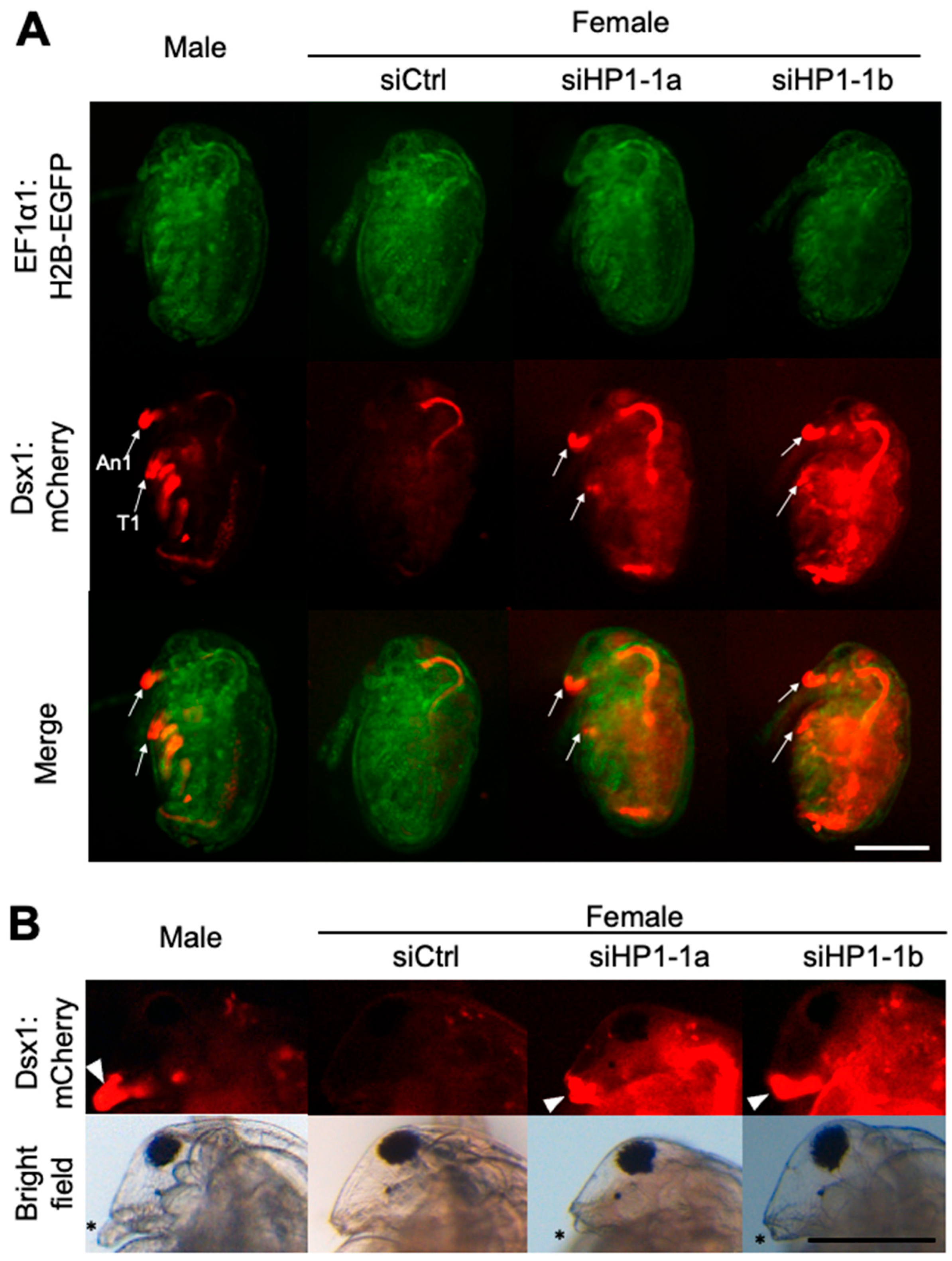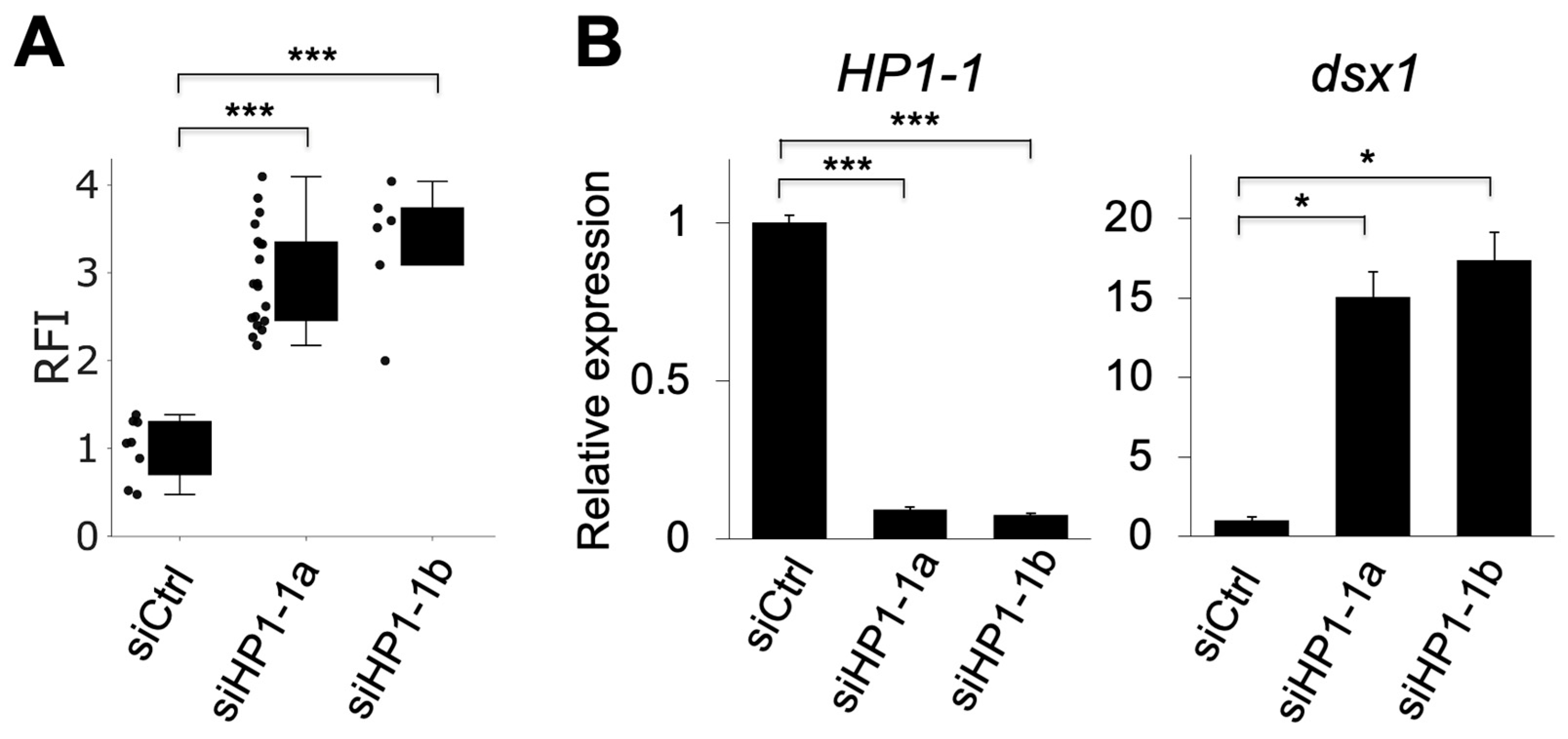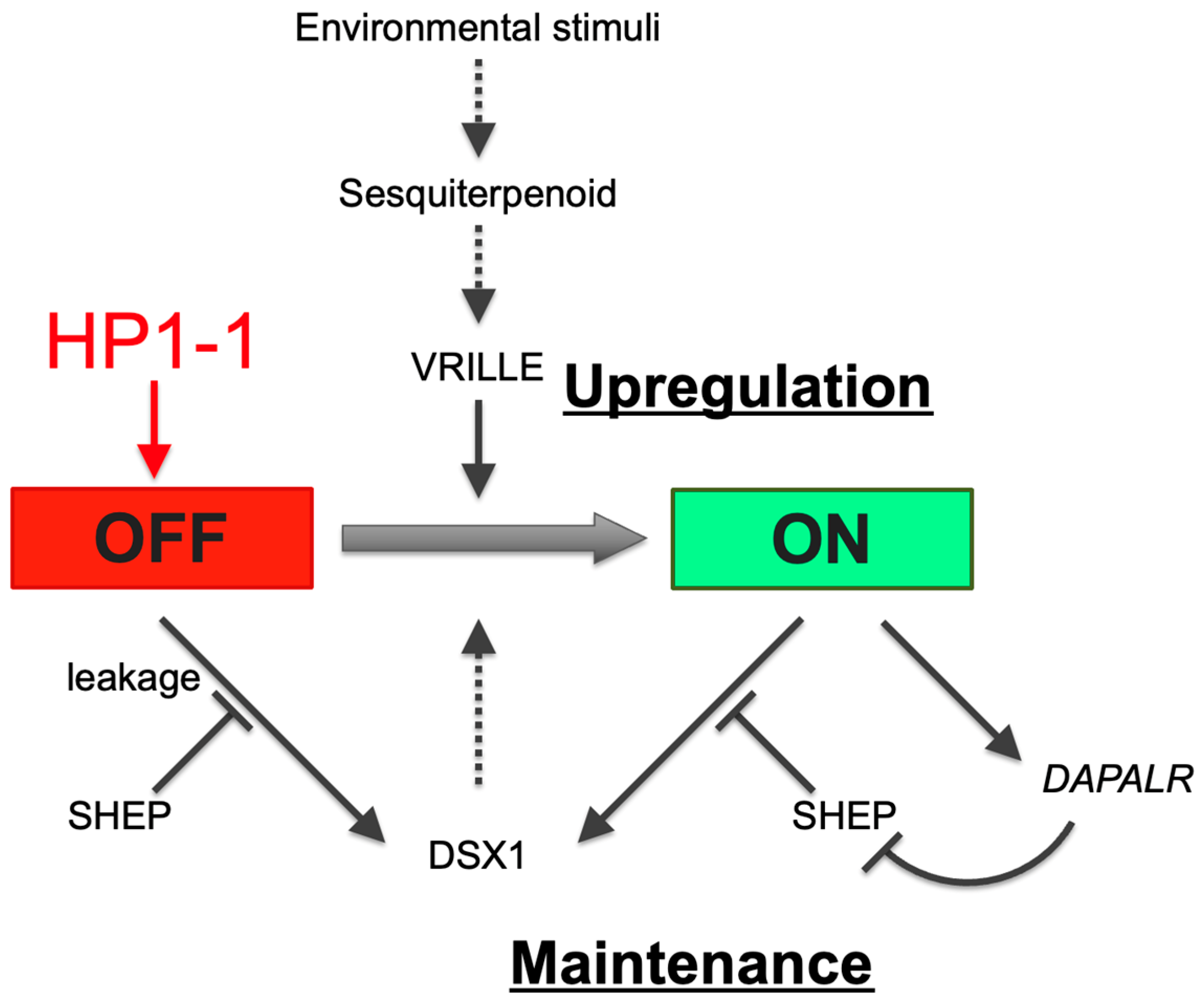HP1-Mediated Silencing of the Doublesex1 Gene for Female Determination in the Crustacean Daphnia magna
Abstract
1. Introduction
2. Materials and Methods
2.1. Daphnia Strain and Transgenic Lines Culture
2.2. Hormone Treatment
2.3. Identification and Alignment of HP1 Orthologs
2.4. Quantitative RT-PCR
2.5. Microinjection
2.6. HP1-1 RNAi
2.7. Ectopic Expression of HP1-1
2.8. Quantitation of the Fluorescence
3. Results
3.1. Four HP1 Orthologs on the D. magna Genome
3.2. HP1-1 Is the Most Abundantly Expressed During Embryogenesis Among HP1 Orthologs
3.3. HP1-1 Silencing Derepressed Dsx1 and Led to Masculinization in Female Embryos
3.4. HP1-1 Overexpression Alone Did Not Change Dsx1 Expression in Male Embryos
4. Discussion
4.1. Conserved Structure and Sex-Specific Function of HP1-1
4.2. Environmental Sex-Determining Mechanisms in D. magna
4.3. Epigenetic Regulation for Sex Determination
Supplementary Materials
Author Contributions
Funding
Institutional Review Board Statement
Informed Consent Statement
Data Availability Statement
Acknowledgments
Conflicts of Interest
References
- Zarkower, D. Establishing Sexual Dimorphism: Conservation amidst Diversity? Nat. Rev. Genet. 2001, 2, 175–185. [Google Scholar] [CrossRef] [PubMed]
- Korpelainen, H. Sex Ratios and Conditions Required for Environmental Sex Determination in Animals. Biol. Rev. 1990, 65, 147–184. [Google Scholar] [CrossRef]
- Gamble, T.; Zarkower, D. Sex Determination. Curr. Biol. 2012, 22, R257–R262. [Google Scholar] [CrossRef]
- Burtis, K.C.; Baker, B.S. Drosophila Doublesex Gene Controls Somatic Sexual Differentiation by Producing Alternatively Spliced mRNAs Encoding Related Sex-Specific Polypeptides. Cell 1989, 56, 997–1010. [Google Scholar] [CrossRef]
- Smith, C.A.; Roeszler, K.N.; Ohnesorg, T.; Cummins, D.M.; Farlie, P.G.; Doran, T.J.; Sinclair, A.H. The Avian Z-Linked Gene DMRT1 Is Required for Male Sex Determination in the Chicken. Nature 2009, 461, 267–271. [Google Scholar] [CrossRef]
- Raymond, C.S.; Murphy, M.W.; O’Sullivan, M.G.; Bardwell, V.J.; Zarkower, D. Dmrt1, a Gene Related to Worm and Fly Sexual Regulators, Is Required for Mammalian Testis Differentiation. Genes Dev. 2000, 14, 2587–2595. [Google Scholar] [CrossRef]
- Ge, C.; Ye, J.; Zhang, H.; Zhang, Y.; Sun, W.; Sang, Y.; Capel, B.; Qian, G. Dmrt1 Induces the Male Pathway in a Turtle Species with Temperature-Dependent Sex Determination. Development 2017, 144, 2222–2233. [Google Scholar] [CrossRef] [PubMed]
- Kato, Y.; Kobayashi, K.; Watanabe, H.; Iguchi, T. Environmental Sex Determination in the Branchiopod Crustacean Daphnia magna: Deep Conservation of a Doublesex Gene in the Sex-Determining Pathway. PLoS Genet. 2011, 7, e1001345. [Google Scholar] [CrossRef] [PubMed]
- Hebert, P.D.N. The Population Bilogy of Daphnia (Crustacea, Daphnidae). Biol. Rev. 1978, 53, 387–426. [Google Scholar] [CrossRef]
- Kato, Y.; Watanabe, H. Regulation of Doublesex1 Expression for Environmental Sex Determination in the Cladoceran Crustacean Daphnia. Front. Cell Dev. Biol. 2022, 10, 881255. [Google Scholar] [CrossRef]
- Nong, Q.D.; Mohamad Ishak, N.S.; Matsuura, T.; Kato, Y.; Watanabe, H. Mapping the Expression of the Sex Determining Factor Doublesex1 in Daphnia magna Using a Knock-in Reporter. Sci. Rep. 2017, 7, 13521. [Google Scholar] [CrossRef]
- Lomberk, G.; Wallrath, L.; Urrutia, R. The Heterochromatin Protein 1 Family. Genome Biol. 2006, 7, 228. [Google Scholar] [CrossRef] [PubMed]
- Zeng, W.; Ball, A.R., Jr.; Yokomori, K. HP1: Heterochromatin Binding Proteins Working the Genome. Epigenetics 2010, 5, 287–292. [Google Scholar] [CrossRef] [PubMed]
- Eissenberg, J.C.; James, T.C.; Foster-Hartnett, D.M.; Hartnett, T.; Ngan, V.; Elgin, S.C. Mutation in a Heterochromatin-Specific Chromosomal Protein Is Associated with Suppression of Position-Effect Variegation in Drosophila Melanogaster. Proc. Natl. Acad. Sci. USA 1990, 87, 9923–9927. [Google Scholar] [CrossRef] [PubMed]
- Ayyanathan, K.; Lechner, M.S.; Bell, P.; Maul, G.G.; Schultz, D.C.; Yamada, Y.; Tanaka, K.; Torigoe, K.; Rauscher, F.J. Regulated Recruitment of HP1 to a Euchromatic Gene Induces Mitotically Heritable, Epigenetic Gene Silencing: A Mammalian Cell Culture Model of Gene Variegation. Genes Dev. 2003, 17, 1855–1869. [Google Scholar] [CrossRef]
- Arabidopsis TERMINAL FLOWER 2 Gene Encodes a Heterochromatin Protein 1 Homolog and Represses Both FLOWERING LOCUS T to Regulate Flowering Time and Several Floral Homeotic Genes|Plant and Cell Physiology|Oxford Academic. Available online: https://academic.oup.com/pcp/article-abstract/44/6/555/1834078?redirectedFrom=fulltext (accessed on 1 June 2025).
- Levine, M.T.; McCoy, C.; Vermaak, D.; Lee, Y.C.G.; Hiatt, M.A.; Matsen, F.A.; Malik, H.S. Phylogenomic Analysis Reveals Dynamic Evolutionary History of the Drosophila Heterochromatin Protein 1 (HP1) Gene Family. PLoS Genet. 2012, 8, e1002729. [Google Scholar] [CrossRef]
- Studencka, M.; Wesołowski, R.; Opitz, L.; Salinas-Riester, G.; Wisniewski, J.R.; Jedrusik-Bode, M. Transcriptional Repression of Hox Genes by C. Elegans HP1/HPL and H1/HIS-24. PLoS Genet. 2012, 8, e1002940. [Google Scholar] [CrossRef]
- Liu, L.-P.; Ni, J.-Q.; Shi, Y.-D.; Oakeley, E.J.; Sun, F.-L. Sex-Specific Role of Drosophila Melanogaster HP1 in Regulating Chromatin Structure and Gene Transcription. Nat. Genet. 2005, 37, 1361–1366. [Google Scholar] [CrossRef]
- Brown, J.P.; Bullwinkel, J.; Baron-Lühr, B.; Billur, M.; Schneider, P.; Winking, H.; Singh, P.B. HP1γ Function Is Required for Male Germ Cell Survival and Spermatogenesis. Epigenet. Chromatin 2010, 3, 9. [Google Scholar] [CrossRef]
- Klüttgen, B.; Dülmer, U.; Engels, M.; Ratte, H.T. ADaM, an Artificial Freshwater for the Culture of Zooplankton. Water Res. 1994, 28, 743–746. [Google Scholar] [CrossRef]
- Tatarazako, N.; Oda, S.; Watanabe, H.; Morita, M.; Iguchi, T. Juvenile Hormone Agonists Affect the Occurrence of Male Daphnia. Chemosphere 2003, 53, 827–833. [Google Scholar] [CrossRef] [PubMed]
- Kato, Y.; Kobayashi, K.; Oda, S.; Tatarazako, N.; Watanabe, H.; Iguchi, T. Sequence Divergence and Expression of a Transformer Gene in the Branchiopod Crustacean, Daphnia magna. Genomics 2010, 95, 160–165. [Google Scholar] [CrossRef] [PubMed]
- Olmstead, A.W.; Leblanc, G.A. Juvenoid Hormone Methyl Farnesoate Is a Sex Determinant in the Crustacean Daphnia magna. J. Exp. Zool. 2002, 293, 736–739. [Google Scholar] [CrossRef]
- Stothard, P. The Sequence Manipulation Suite: JavaScript Programs for Analyzing and Formatting Protein and DNA Sequences. BioTechniques 2000, 28, 1102–1104. [Google Scholar] [CrossRef] [PubMed]
- Kato, Y.; Shiga, Y.; Kobayashi, K.; Tokishita, S.; Yamagata, H.; Iguchi, T.; Watanabe, H. Development of an RNA Interference Method in the Cladoceran Crustacean Daphnia magna. Dev. Genes Evol. 2011, 220, 337–345. [Google Scholar] [CrossRef]
- Elendt, B.-P.; Bias, W.-R. Trace Nutrient Deficiency in Daphnia magna Cultured in Standard Medium for Toxicity Testing. Effects of the Optimization of Culture Conditions on Life History Parameters of D. Magna. Water Res. 1990, 24, 1157–1167. [Google Scholar] [CrossRef]
- Kamola, P.J.; Nakano, Y.; Takahashi, T.; Wilson, P.A.; Ui-Tei, K. The siRNA Non-Seed Region and Its Target Sequences Are Auxiliary Determinants of Off-Target Effects. PLoS Comput. Biol. 2015, 11, e1004656. [Google Scholar] [CrossRef]
- Kato, Y.; Matsuura, T.; Watanabe, H. Genomic Integration and Germline Transmission of Plasmid Injected into Crustacean Daphnia magna Eggs. PLoS ONE 2012, 7, e45318. [Google Scholar] [CrossRef]
- Hansson, M.D.; Rzeznicka, K.; Rosenbäck, M.; Hansson, M.; Sirijovski, N. PCR-Mediated Deletion of Plasmid DNA. Anal. Biochem. 2008, 375, 373–375. [Google Scholar] [CrossRef]
- Trichas, G.; Begbie, J.; Srinivas, S. Use of the Viral 2A Peptide for Bicistronic Expression in Transgenic Mice. BMC Biol. 2008, 6, 40. [Google Scholar] [CrossRef]
- Kim, J.H.; Lee, S.-R.; Li, L.-H.; Park, H.-J.; Park, J.-H.; Lee, K.Y.; Kim, M.-K.; Shin, B.A.; Choi, S.-Y. High Cleavage Efficiency of a 2A Peptide Derived from Porcine Teschovirus-1 in Human Cell Lines, Zebrafish and Mice. PLoS ONE 2011, 6, e18556. [Google Scholar] [CrossRef]
- Törner, K.; Nakanishi, T.; Matsuura, T.; Kato, Y.; Watanabe, H. Optimization of mRNA Design for Protein Expression in the Crustacean Daphnia magna. Mol. Genet. Genom. 2014, 289, 707–715. [Google Scholar] [CrossRef]
- Jacobs, S.A.; Khorasanizadeh, S. Structure of HP1 Chromodomain Bound to a Lysine 9-Methylated Histone H3 Tail. Science 2002, 295, 2080–2083. [Google Scholar] [CrossRef] [PubMed]
- Cowieson, N.P.; Partridge, J.F.; Allshire, R.C.; McLaughlin, P.J. Dimerisation of a Chromo Shadow Domain and Distinctions from the Chromodomain as Revealed by Structural Analysis. Curr. Biol. 2000, 10, 517–525. [Google Scholar] [CrossRef] [PubMed]
- Mittmann, B.; Ungerer, P.; Klann, M.; Stollewerk, A.; Wolff, C. Development and Staging of the Water Flea Daphnia magna (Straus, 1820; Cladocera, Daphniidae) Based on Morphological Landmarks. EvoDevo 2014, 5, 12. [Google Scholar] [CrossRef]
- Ishak, N.S.M.; Nong, Q.D.; Matsuura, T.; Kato, Y.; Watanabe, H. Co-Option of the bZIP Transcription Factor Vrille as the Activator of Doublesex1 in Environmental Sex Determination of the Crustacean Daphnia magna. PLoS Genet. 2017, 13, e1006953. [Google Scholar] [CrossRef]
- Tanaka, K.; Barmina, O.; Sanders, L.E.; Arbeitman, M.N.; Kopp, A. Evolution of Sex-Specific Traits through Changes in HOX-Dependent Doublesex Expression. PLoS Biol. 2011, 9, e1001131. [Google Scholar] [CrossRef] [PubMed]
- Grmai, L.; Jimenez, E.; Baxter, E.; Doren, M.V. Steroid Signaling Controls Sex-Specific Development in an Invertebrate. BioRxiv 2024. [Google Scholar] [CrossRef]
- Perez, C.A.G.; Adachi, S.; Nong, Q.D.; Adhitama, N.; Matsuura, T.; Natsume, T.; Wada, T.; Kato, Y.; Watanabe, H. Sense-Overlapping lncRNA as a Decoy of Translational Repressor Protein for Dimorphic Gene Expression. PLoS Genet. 2021, 17, e1009683. [Google Scholar] [CrossRef]
- Kato, Y.; Perez, C.A.G.; Mohamad Ishak, N.S.; Nong, Q.D.; Sudo, Y.; Matsuura, T.; Wada, T.; Watanabe, H. A 5′ UTR-Overlapping LncRNA Activates the Male-Determining Gene Doublesex1 in the Crustacean Daphnia magna. Curr. Biol. 2018, 28, 1811–1817.e4. [Google Scholar] [CrossRef]
- Koopman, P.; Gubbay, J.; Vivian, N.; Goodfellow, P.; Lovell-Badge, R. Male Development of Chromosomally Female Mice Transgenic for Sry. Nature 1991, 351, 117–121. [Google Scholar] [CrossRef] [PubMed]
- Kuroki, S.; Tachibana, M. Epigenetic Regulation of Mammalian Sex Determination. Mol. Cell. Endocrinol. 2018, 468, 31–38. [Google Scholar] [CrossRef] [PubMed]
- Ge, C.; Ye, J.; Weber, C.; Sun, W.; Zhang, H.; Zhou, Y.; Cai, C.; Qian, G.; Capel, B. The Histone Demethylase KDM6B Regulates Temperature-Dependent Sex Determination in a Turtle Species. Science 2018, 360, 645–648. [Google Scholar] [CrossRef] [PubMed]
- Gómez, R.; Van Damme, K.; Gosálvez, J.; Morán, E.S.; Colbourne, J.K. Male Meiosis in Crustacea: Synapsis, Recombination, Epigenetics and Fertility in Daphnia magna. Chromosoma 2016, 125, 769–787. [Google Scholar] [CrossRef]






| siRNA | Injected Embryo | Hatched Embryo | Survived Juvenile | Immobile Juvenile | Increase of mCherry Fluorescence |
|---|---|---|---|---|---|
| siCtrl | 9 | 9 | 8 | 0 | 0% (0/8) |
| siHP1-1a | 23 | 22 | 18 | 18 | 100% (18/18) |
| siHP1-1b | 10 | 10 | 6 | 6 | 100% (6/6) |
Disclaimer/Publisher’s Note: The statements, opinions and data contained in all publications are solely those of the individual author(s) and contributor(s) and not of MDPI and/or the editor(s). MDPI and/or the editor(s) disclaim responsibility for any injury to people or property resulting from any ideas, methods, instructions or products referred to in the content. |
© 2025 by the authors. Licensee MDPI, Basel, Switzerland. This article is an open access article distributed under the terms and conditions of the Creative Commons Attribution (CC BY) license (https://creativecommons.org/licenses/by/4.0/).
Share and Cite
Leim, J.; Adhitama, N.; Nong, Q.D.; Religia, P.; Kato, Y.; Watanabe, H. HP1-Mediated Silencing of the Doublesex1 Gene for Female Determination in the Crustacean Daphnia magna. J. Dev. Biol. 2025, 13, 23. https://doi.org/10.3390/jdb13030023
Leim J, Adhitama N, Nong QD, Religia P, Kato Y, Watanabe H. HP1-Mediated Silencing of the Doublesex1 Gene for Female Determination in the Crustacean Daphnia magna. Journal of Developmental Biology. 2025; 13(3):23. https://doi.org/10.3390/jdb13030023
Chicago/Turabian StyleLeim, Junya, Nikko Adhitama, Quang Dang Nong, Pijar Religia, Yasuhiko Kato, and Hajime Watanabe. 2025. "HP1-Mediated Silencing of the Doublesex1 Gene for Female Determination in the Crustacean Daphnia magna" Journal of Developmental Biology 13, no. 3: 23. https://doi.org/10.3390/jdb13030023
APA StyleLeim, J., Adhitama, N., Nong, Q. D., Religia, P., Kato, Y., & Watanabe, H. (2025). HP1-Mediated Silencing of the Doublesex1 Gene for Female Determination in the Crustacean Daphnia magna. Journal of Developmental Biology, 13(3), 23. https://doi.org/10.3390/jdb13030023






